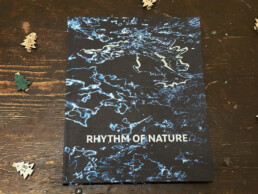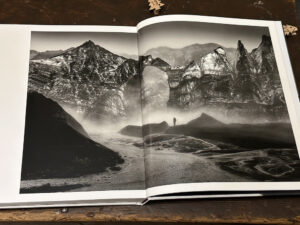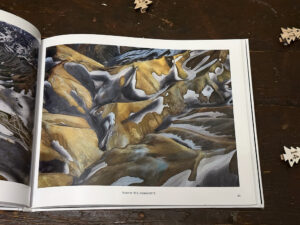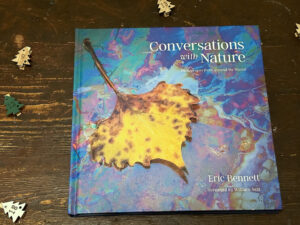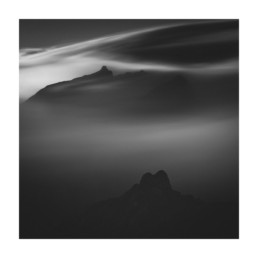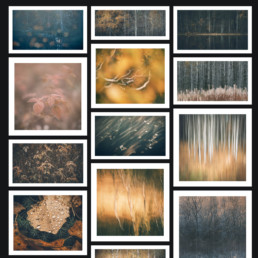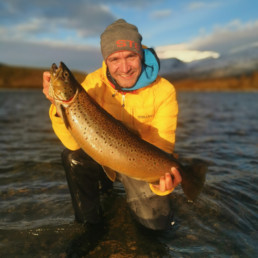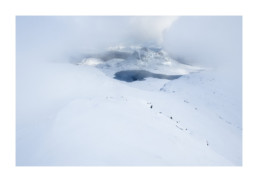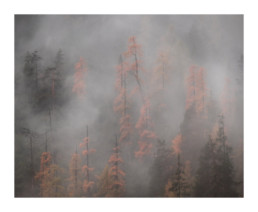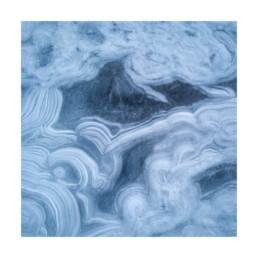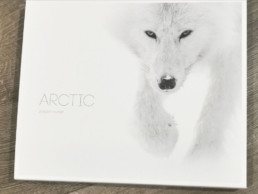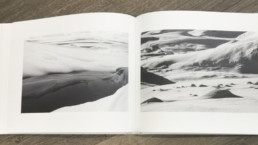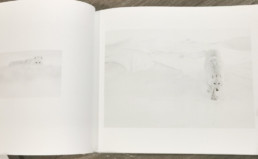5 photobooks to add to your collection!
Over the last few years i have built up quite the collection of photo books. They are now filling up large spaces in my house and the collection keeps growing. Most of the books are fantastic works where you really can tell that the author has put a lot of love and effort into the process. There is nothing that beats the level of inspiration i get from sitting down with a glass of wine while looking through a great photobook. So without further introduction, here are 5 photobooks i got over the last year that everyone should have in their collection. Ive also taken crappy iphone shots of my favourite photo in each one. I will make more detailed presentations of these at a later point.
1. Rhythm of Nature by Sandra Bartocha
This one is a true treasure in my collection. Its probably the book with the most photos that left me speechless. Bartocha sees things like no one else. I can spend ages just looking at each photo. Dont think, just get it. Order it here.
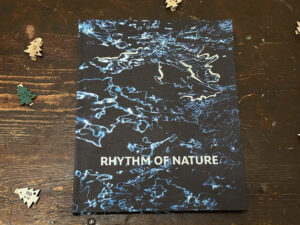

2. Mitt Land by Trym Ivar Bergsmo
Trym Ivar Bergsmo is an incredible artist, the grand old man of landscape photographers here in the north. This epic book is filled with a fantastic mix of grand scenes and smaller scenes that makes your mid wander. Prder your copy here.
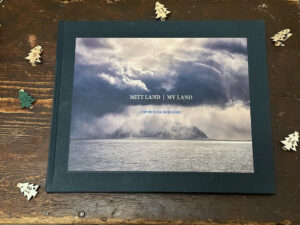
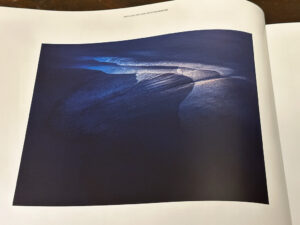
3. Where the World is Melting by Ragnar Axelsson
Ragnar Axelsson (RAX) is one of my all time favourites and i recommend having a look at all of his books. This latest one is a great start though, it has some of the best works from all of his previous releases. I can look at his incredible black and white work over and over. Order it here.
4. Beyond Landscape by Hans Strand
Hans Strand is a brilliant photographer with several books published through a career that spans decades. This book showcases some of his very best work and its a must in every photographers book shelf. Order it here.
5. Conversations with Nature by Eric Bennett
This one is a true beauty. Its filled with inspirational work from beginning to end. Its like a “best of” collection from all around the world, i was impressed for every page i turned! Order it here.
Behind the shot - Floating Peaks
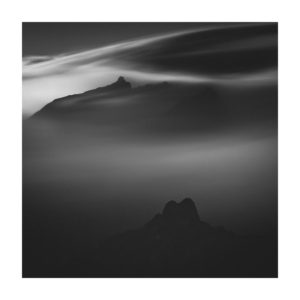
Last November i spent a week on the incredible island of Madeira together with some great friends. Its located far out in the Atlantic ocean and in November there are clouds rolling in from the Atlantic creating an incredible playground for those of us who enjoy photographing fog. And there is nothing i enjoy more than photographing in fog!
After an incredible day of swimming, laughing and trying to get the fog in just the right places, we decided to drive up to Pico do Ariero to try to capture the open views from the second highest peak on the island. I had low expectations, i have seen some serious mountains in my life and it takes quite a bit of scenery to impress me when it comes to mountains. What we experience blew my mind! The peaks surrounding Pico do Ariero reminds me of the Dolomites, and when the low clouds drifted through the peaks in incredible speeds i was beyond excited! The wind was horrendous and it was almost impossible to get a sharp shot since everything was vibrating. I am working mostly with long exposures these days so it was extra challenging. I did mostly 1 minute exposures, more than enough to create an incredible atmosphere and sense of motion. The clouds diffused parts of hte mountains creating incredible depth to the scene. I was extremely lucky having the closest peak totally clear for the minute i was exposing and i was perfectly balancing the rest of the scene. I love the mystery and atmosphere in this photo, two of the main things i dream about when im out shooting. I kept the scene dark, revealing only parts of the scene. The result is one of my very favourite mountain pictures!
I cant wait to go back to Madeira when we host our first workshop here this coming November.
Fuji GFX 50S - Canon 135mm f2 @ f5.6 - iso 100 - 60 sec
Interview with GDT Forum Naturfotografie
Back in winter, while i was still waiting for the books to arrive, i did a big interview with Jan Zwilling for the German magazine Forum Naturfotografie. I rarely do interviews, mainly because i feel its hard to express my artistic ideas and opinions in writing. This was an exception and its an in-depth look at the book project as well a look at who i am artistically. I quite enjoyed it and i thought it might be a good idea to present it in English since its only been available in German.
The interview was published in edition 1 of Forum Naturfotografie 2021.


You grew up and still live in a part of the world that many landscape photographers consider a
dreamland, Arctic Norway. When did you first realize the visual potential in your home and what did
your first photographic attempts look like?
I feel extremely blessed living in this part of the world. Im surrounded by beautiful landscapes
everywhere. I was aware of the beauty and potential even before I picked up a camera for the first
time. I remember being a bit annoyed that the mountains I hiked around in wasn’t mentioned in
the same way as the fjord region in the south, or Lofoten here in the north. Ofcourse, im very
subjective in this. I have a deep emotional connection to these places, and im sure a lot of people
can relate to a feeling of ownership to specific areas. But seeing and feeling this beauty does not
mean its easy to transfer into a pleasing photo. This area is less instant than a lot of the iconic
places. There are no immediate compositions, no mountains jumping in your face. Its more
“hidden” and requires a bit more effort to find the good spots. And even though I knew the area
really well when I started photographing it, I still needed years and years until I got any results that
I was happy with. Looking back at my first attempts, over the first few years, I can see that it was
all a learning process. I was trying to copy my inspirations and finding places in my home area that
would resemble images that inspired me. The results was not good at all, but it was great for
learning.
A lot has changed since then, since Lofoten Islands became an A-list location for landscape
photography. How did you experience this development?
Lofoten is a place that I wasn’t very familiar with before I started my photography. Even though I
only need to drive for 2 hours to get there, it was never a place I visited and explored growing up. I
had been there many times, but only to play football. So my visual experience was through a bus
window. Watching mountains pass by.
But when I went there for the first time as a photographer, things got very interesting. This was
before everyone went there and only a few people were running tours to the area. I did a short trip
with my good friend Antony Spencer, where we went to Reine and Skagsanden Beach in stunning
winter conditions and I remember we were all alone out there. There was no other people! And it
stayed quiet like that for a few years. I did my first tour with clients out there in early 2014, and it
was still very quiet. Hardly anyone around. But over the next 3-4 years I could literally see things
change in front of my eyes. It became difficult to visit the famous locations without sharing it with
numerous other groups. The experience wasn’t the same anymore, but by going to lesser known
places we were able to shy away from the crowds to some extent.
The great thing about Lofoten is that the area controls itself in a way. The infrastructure isn’t set
up to handle more people than what is already there. There are no big hotels that can
accommodate hundreds of people, luckily. And I hope it stays this way in the future, but I guess it’s
the same as anywhere else, money will decide.
You differ between the photographers’ playground which is Lofoten and Senja Islands, and your
backyard of mountains on the mainland. Is it also because you want protect your very home place to
a certain degree from becoming overrun?
From the very beginning I have treated my home area different to Lofoten and Senja and other hot
spots. I knew I had to, in order to protect the area. Even though I love bringing people into the
mountains and showing them the incredible beauty and atmosphere that lies beyond the easy
accessible spots. Once every summer I bring a small group into the mountains where we hike
through the whole area over a week. Its my favourite trip every year. Whats most incredible to the
ones who have done this trip, is that over a week we might cross paths with one or two reindeer
herders or a lonely local hiker. The solitude and feeling of wilderness is fantastic. I want to keep it
like this. It’s a fragile environment, and it needs to be protected. Thankfully, like I mentioned
earlier, its not visually obvious. On the surface there is nothing special about the area. So its not as
attractive to people driving through the surrounding areas. When people arrive at Evenes Airport,
they have no clue that when they get out of the terminal they are looking straight up at my Misty
Mountains.
Also, and maybe its more important to me than im aware of myself, the area has a great personal
value for me. It holds a lot of my soul, like a part of me permanently resides between the
mountains. So many memories from my life. And I don’t want to ruin that personal connection by
seeing hordes of people in the area.
You’re also riding the wave and offer guided tours in your home region. How do you feel with being a
part of the machinery which has ambivalent effects on the regions?
Im not only riding the wave. To some degree I feel like one of the few that put that wave into
motion. And it’s a bittersweet feeling. It has made me able to make a living of photography,
something I never even dreamt of. At the same time the effect tourism has on the fragile arctic
environment is heart breaking at times. But, I think it was inevitable. Photo tours is one thing, but
its nothing compared to the effect social media has had on incoming travel to Lofoten. The amount
of travellers going to Lofoten to get their Instagram shots is just beyond imagination. There are so
many! In part, the photo tour business showcased the spots to the public and from there it just
went crazy. Luckily a place like Lofoten will to some degree limit itself due to the lack of hotels on
the islands. There are just a few large hotels and none in the most spectacular areas. So the area
can only fit so many. I hope the local authorities wont allow huge hotels to be built in places like
Reine, that would totally destroy the area.
Did these icon-hunting and light-chasing adventures drift apart from the kind of photography your do
for yourself? Is running photo tours still about you personally photographing?
I don’t do icon-hunting myself, but I can certainly understand the value it has for the people that
travel to these remote places. I have tried so many times to steer the attention away from the
great icons and instead making people enjoy finding the more quiet and less obvious scenes. But
the majority prefers to take pictures of the famous spots. I cant remember the last time I took a
photo at the famous spots, even though I take groups to these places several times every year. Its
not about my photography, its about showing people who have never been to these places.
Showing them whats possible. I still get a lot of joy from seeing the excitement in peoples eyes
when they see these incredible places. Over the years we have also put more emphasis on the
learning aspect on our trips. We want people to have tons of fun and go home with lots of great
pictures, but also with fresh knowledge and a sense of having grown as photographers.
For me personally I have learnt to challenge myself on these trips. I try to photograph the places in
a different way. It could be that I try to do only long exposures of simple subjects, or that I shoot
with a specific focal length for the entire week. Things to keep me on my toes and push myself
while going to the same places. That way I stay inspired.
Anybody who knows you knows that you’re easily excited, both by joyful company during tours and
by the bliss of solitude while photographing. What, in the end is more truly Arild?
Solitude. I enjoy being alone in nature. Im more relaxed and focused. Im a better photographer
when im by myself. But youre right, I really enjoy the social side of the tours and I like being with
other people. I find it so interesting to talk to others, not only about photography, but about life in
general. Its one of the things I enjoy the most about running tours. Getting to know the people.
Making people happy and excited is a great thrill.
But its when im all alone that my weirdest ideas come to life and I can let my creativity run freely. I
slow down when im by myself. When im taking pictures with others im always working really fast,
sometimes too fast. Its only when im alone that im able to slow it down properly.
I have noticed that more recently your photography become more simple and subtle, deep and
thoughtful. I know you always enjoyed the reduced, almost abstract winter photography for example
by Bruce Percy. Would you say that this “style” has become your personal signature style?
I always thought my signature style was that I have no signature style. There is too much going on
and my work is all over the place. But I certainly see what you mean. Bruce Percy has been a
source of inspiration for many years and his approach definitely had an impact on my work. Him
and many others. I am truly comfortable working with simplistic compositions as my
compositional vision seems fine tuned towards those types of images. I think we as photographers
are tuned in on certain frequencies when we are out looking for compositions. We scan the scenes
differently and what triggers me might not trigger you and vice versa. In a way the term “simple”
or “simplistic” is a bit mis-leading at times, since it almost implies that these types of images are
easy to make. That they are simple. When in fact they are so difficult to master. To make them
interesting and engaging for the viewer is quite difficult. For many years I ran around with my wide
angle, creating near-far compositions with impressive foregrounds and backgrounds. Put a
waterfall in the foreground and a pointy peak in the background. These are some of the easiest
images to make.
Im not attracted to pure beauty of nature. The cliché impression of beauty in the form of nice
colours and impressive views. It doesn’t challenge me at all and I don’t feel anything when looking
at those kinds of images. Im more and more attracted to the mundane, to the unnoticed and
anonymous. Theres more complexity and interest in the less obvious.
Now im in a place where im both comfortable with how I work, but also constantly pushing myself
to think outside the box. Its so different from where I was only a few years back and couldn’t have
been happier about where I am!
You have now photographed in many places all around the world, but still are bound closely to your
home region. When did you realize you work on a project called “Heime – Home”?
There is something about feeling connected to a place. Working in the same area for years. I enjoy
travelling, visiting an area for a week before returning back home. On these trips its all about
making the most out of the days at my disposal. No time to miss. While I mostly return with
images im happy with, its completely different when working in my home area. Here I can witness
nature around me throughout the seasons. I can go out when I know the conditions are right and
my photos are far more fine-tuned in a way. Around 10 years ago I started thinking about putting
together a book with a focus on my home mountains. I had a very long term plan for this and
didn’t expect it to materialize anytime soon. But as time passed and I built an archive of images
from all these places here at home, I realized that I had been thinking to narrow and I needed to
widen the horizon a little. There was just so much outside the pure mountain scenes, things that
screamed for attention. My life as an outdoor enthusiast has not only been focused on the
mountains. I grew up in a forest area, with lakes, rivers and huge birch forests. These more quiet
places has played a huge role in shaping me into the person I am today. And one day it suddenly
dawned on me, I need to make this project about all of this. My home. That’s when the title
“Heime” fell in my head. From there everything fell naturally into place and the project picked up
speed quite quickly.
Is “Heime” more a photographic project in the sense that you conceptualize a consistent series of
photographs or is it rather a curative project, selecting and reworking images for publication?
Perhaps it’s a mix of both. I spent a long time with sequencing and page layout. A large portion of
the images I took specifically for the book and most often as a supporting act for another image. I
often show a grander scene accompanied by a smaller more intimate scene. A lot of the images in
Heime cannot stand alone. I cant post them online since they make no sense without the other
image. Alone they are too weak, but together they grow and come to life.
Setting up the storyline in the book was interesting and time consuming. I wanted to tell a story
where I take the viewer through the seasons, showing a huge variety of scenery. Making this
harmonious and avoiding making a chaotic mess was hard. Im not sure I succeeded 100%, but i`ll
let others decide on that.
Home has a very personal connotation, implying it is as much about you as it is about a place. In
which way are the photographs subjective and personal?
I have given this a lot of thought lately. All the images mean a lot to me. I connect deeply with each
of them. But the challenge is to pass this on to the readers. All the images I captured because they
mean something to me for all kinds of reasons. There is an image showing nothing but a gentle
wind blowing on a lake. It’s about as anonymous as it gets. Yet I feel deeply connected to it. I have
spent more hours than I can remember just looking at wind on a lake. As you probably know I am a
passionate sportsfisherman, and I spend a lot of time out in the mountains fishing for trout. Often I
can sit overlooking a lake studying wind patterns and looking for fish. It’s a very zen-like
experience for me. When I look at that particular image in the book, I am instantly taken back to
that feeling. A feeling of calm and being in balance. Im sure very few will feel the same when they
look at it.
A lot of the images are the same, although not to that same degree of subjectiveness. They are
connected to parts of my brain and memories that the readers might not relate to. Or they might
relate to them in totally different ways and perhaps link them to something in their own memories
or emotional library. That’s the beauty of photographs. If I can make the readers go on a journey
while looking through my book, to feel something, an atmosphere, something that makes them
feel and dream themselves away. Then I have succeeded.
I also hope that the book will challenge people a bit. The worst response I can get is “wow, these
are pretty photos”. I much rather hope someone will say “this is total nonsense and I don’t
understand.”
Much of today’s photography ridicules notions of personal connection to the subject or deeper
meaning, because it is short-lived in digital files and social media hypes. Why it is important to you
that “Heime” is a book?
I think it’s a shame that almost all photographs are doomed to live a life where they get attention
for 1 second while being scrolled by on a small phone screen. I see all these amazing photographs
every day and I wonder what happens to them. Most are just buried in a social media feed never
to be appreciated properly in a print. To me, a book is the ultimate way of viewing a
photographers work. I have a nice collection of photo books and there is nothing quite as
inspirational as sitting down with a glass of red while looking through an amazing photo book.
And it was important for me to present this project in the best possible way. I could do that in a
gallery on my website, but that didn’t feel right at all. I want the viewer to take his time to really
take in the work properly, and by doing this in a book, with careful sequencing, I could really
present it exactly how I wanted.
A large portion of my work is subtle. Social media is a disaster for subtle photography. Instagram
and Facebook is great for the fantastical landscapes with impressive elements. The ones that
succeeds the most on these platforms have very instant photographs with hardly any subtlety.
Books and prints is a different game and it’s the right way to absorb and “get lost” in subtle
photography.
One advantage of a book is that it forces to perceive a body of work as exactly this, a body of work as
opposed to single photographs back to back. How important was it for you not to select the very best
individual photographs but those that harmonize best?
The importance of balance and harmony in the image selection is very underrated. I had some
photographs that I loved, but I couldn’t make them work within the book. They felt “off” and
misplaced. Deciding to leave them out was tough, but necessary. I think it is easy and tempting,
when working on a book, to think that only the best photographs should be presented. Putting
together a “best-of collection” where you only choose to showcase the perfect photos. In my
opinion its far from the best solution. Each spread should tell a story and harmonize. That was an
eye-opening experience throughout the project. There are 248 pages in the book, it takes a long
time for the reader to look through it all. It’s not a 15 minute experience, but rather something to
be absorbed over several sessions. When looking through a large amount of photographs, the
importance of having some photographs that allows your eyes to rest, even including numerous
blank pages, cannot be underestimated.
You worked on the book during much of the pandemic, which seems to have been an intense,
inspired and productive time for you. You refer to the result as “100% me”. Can you describe how
you worked on all aspects of the book, and how working on the layout for example interacted with
still photographing for the book?
When the project really came to life and I started working on the layout and storyline of the book,
the whole thing was like a living breathing creature. I would stay up in the evenings and well into
the night, working on selecting images and sequencing them into the book. How large should this
one be? Does it work with this one? Does it fit after these ones? And quite often I understood that
I needed a specific kind of picture in order to make an already existing photograph work optimally.
So the next day I would climb up in the mountains to take that missing picture. This happened over
and over again and it was exhausting, but so rewarding and inspirational. And all of this while the
world was on pause due to the pandemic. I wouldn’t have been able to finish HEIME without the
break caused by the pandemic. Suddenly I had a calendar filled with nothing but spare time. No
workshops, no travel, just lots of time at my disposal. I did more photography in 2020 than the
previous 5 years combined. And my mind was in a creative bubble where all I could focus on was
the project. I could stay awake at night, unable to sleep, just thinking about how to get a specific
photograph.
The layout of the front page and back page was done by the skilled people at To-Foto in Harstad,
just 20 mins away from my home. They did the design of these things so I didn’t have to worry
about that. It saved me a lot of energy and worry.
It is interesting that you say that finishing the book has left you mentally exhausted and blunt. How
did this come? Are you still in love with your project?
When you work on something so intensely over a long period, all your energy and creativity put
into it, I think its impossible to not be mentally tired when its done. I remember after I sent over
the final draft, I was all empty. I knew deadline had come and all I could do had been done. I was
filled with a feeling of “what now?” What on earth should I do next? I felt no desire to go out and
take pictures. And since the project was all about the area where I live, I was scared of going
outside seeing something incredible and thinking “oh no, this should have been in the book!” I felt
like I was never going to take another picture here again. Luckily I don’t feel like this anymore and
im already looking forward to working even more in these places.
The other thing that has drained me completely over the last couple of months, is the lack of
control. When the book went into printing I had absolutely no control over the process. We had
given them prints of each image so that they knew how the photos should look. Then all I could do
was to sit and wait. The waiting is torture for me. I couldn’t sleep at night, I would stay up thinking
about all the things that could go wrong. What if the book comes and it looks terrible? What if I am
making a fool of myself? All of these worst case scenarios would constantly go through my head.
Now I have already received my advance copy of HEIME and I cant even describe the feeling of joy
and relief when I saw that everything was perfect. Holding the final product in my hands was
incredible. I have looked through it all several times and im immediately taken back to all those
moments when I pressed the shutter. It fills me with happiness and im truly proud of the result.
Looking through older photographs for the book, you said that those “feel like the work of another
person, one that I once knew but have since lost contact with”. Do you expect to feel the same in 15
years, taking “Heime” out of the shelf and thinking back of the Arild of 2020?
I think personal growth and development is very important for every artist. Im now at a place
where I am truly happy with where I am artistically. But I really hope im not in the same place in 15
years. Acknowledging and embracing where we have been is important, just as it is important to
seek new challenges and go in new directions in order to develop. Looking back at my work up
until only a few years back, I can clearly see an immature photographer trying hard to be someone
he wasn’t supposed to be. Trying to create photos with the purpose of impressing others instead of
listening to myself and what I found pleasing. When I finally broke out of that cycle I felt almost
reborn and recharged. I know my future work will have one thing in common, it will be personal
and hopefully visually challenging. I will try continue to develop and seek new visions, but Im also
certain that I will connect deeply with HEIME when I look back at it. After all, its 100% me.
New gallery release!
The fishing season is over. 5 months of hiking, camping and fishing. An everlasting chase for that big elusive trout. Only 7 months until next season… But it feels good to be back at work on my photography again. Last week we returned from our first proper workshop since pre-covid. We spent 6 magnificent days in Finland, photographing bears, wolves and wolverines from hides. It was truly one of the most amazing experiences I’ve ever had as a photographer. But not only did we photograph wildlife, we also took advantage of the amazing fall coloured forests in this remote part of Finland. I enjoyed the landscapes just as much as the wildlife! There is something truly relaxing about wandering around in a quiet forest, trying to sort the compositional puzzle that sometimes can feel overwhelming. I ended up taking a whole series of shots that I’m truly happy with and as a result I decided to put together a new gallery of autumn themed shots from the last couple of years.
Check out the entire gallery here
The coming weekend I’m flying to Oslo to play a football match. I’m too stupid to stop playing, but its just too much fun. Then after a night in Oslo we are flying to Germany to do another Dolomites workshop. It will so good to be back there again, chasing those incredible mountains and views.
Cheers
Arild
Photography Break
I find it to be healthy for my creativity to do longer breaks from photography from time to time. To find some time to let my mind reset and to think about other things. The last couple of years have been very challenging and exhausting for lots of reasons. The main reason being the work with HEIME. Even though it was such a rewarding project, it also nearly brought me to insanity. But now it’s nice to look back at it, getting some distance to the work and I’m actually able to enjoy it properly now.
But the main reason why I’m taking a break from photography and everything related to it… is FISHING! It’s finally time to go chasing the big trouts again! I have been fishing like crazy for the last few weeks already, which is why I haven’t posted anything here. Fishing is where I reset. It’s my mental happy place and I plan to stay in that place for the coming months. So, there wont be much happening here for a bit of time and I wish all of you a great summer and hopefully you will be making lots of great memories.
See ya!
Behind the Shot - Girkoaivi
Girkoaivi – October 2018
I remember this day so clearly. Again, a huge part of what I love about photography and even WHY I photograph, is that it ables me to freeze a moment in time and within that moment is not only the photograph, but also everything else tied up in that moment. The scents, how I felt, what I felt and even my thoughts in that moment. Its like the shutter button also works as a “save-as-button” for everything outside the actual photo.
So when I look at this photo my heart immediately beats faster. I remember being so thrilled and excited about reaching the top of the summit, since this is taken from the summit of the higher neighbouring peak. And a spectacular one might I add. I also had lots of feelings inside me that was bubbling and living its own life, so it was a very pumped and excited version of me that ended up taking this photo.
The photo itself was one of those moments of awe, where you are looking at a scene and suddenly something just opens up and reveals itself. For a brief moment the clouds lifted perfectly around the mountain Girkoaivi. This photo is all about timing. The lake in front of the peak is about to freeze and the fresh snow wasn’t here the day before. So to have the pure white landscape and that blue lake showcased like this, that only happens for a day or two every year. A minute after I took this the scene was gone and I couldn’t see the lake or the mountain.
Its one of those photographs that I cant ever replicate. Just like I cant replicate what I sensed and felt in that very moment. The true essence of photography to me.
Girkoaivi is part of the HEIME book. It can be ordered directly from here.
Here is a shot of me right beneath where I took this.
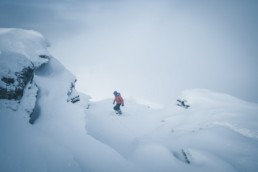
Heime - An Update
It’s been a couple of extremely busy weeks. 2 weeks ago I got a notification saying “the books have arrived”. I was not prepared for what was to come, but most importantly; the books look AMAZING! I couldn’t have been happier about how they turned out. The paper…it just feels so incredible. I achieved the look and feel that I wanted – 100%! It looks almost film like, with muted shadows and lowered contrast. The feel is like a fine art print. Again, I couldn’t have been happier!
I had underestimated the amount of work that goes into packing and shipping. It took me almost 10 days to get all the preorders sent out. I had to put together each slipcase, sign all the books, pack the limited editions properly and then finally protect everything in bubblewrap before putting it in the book cardboard box. Such a tedious and time consuming process and the hours went by so fast! But as soon as I started getting notifications from people all over the world, people telling me how much they love the book, then its all 110% worth it all. It means the world to me to receive so many wonderful responses and there have been moments where I just had to sit down and take it all in. So, to all of you who have bought the book, I’m sending a deep and sincere thanks to all of you!
The limited edition has only 1 copy left – edit: its now sold out. But there are still lots left of the regular edition. So if you want to get your hands on my precious, you can either message me or place an order through the book page. I am shipping as soon as orders come in and the shipping time is impressive. For orders within Europe it takes roughly 2-3 days from you place an order until you have it. Outside Europe its less than a week. Strangely, the slowest shipments are within Norway, thanks to the incredibly slow Norwegian postal service.
I wish all of you a fantastic weekend and hope you have a great one.
Arild
Behind the Shot - Mist Trees
The Dolomites on the border between Italy and Austria are incredible, especially when fall colour explodes and atmosphere reaches its peak. I love this place and I have been returning every year since 2016. Each visit is different, the conditions are never the same and each time I discover new gems. But one thing that never fails is finding random compositions along the way. This is one such random find. Close to the Tre Cime area we stopped the van when we saw low clouds and mist floating around the trees on the mountain slopes. Incredible colours of red and orange on the larch trees! Perfect for a longer lens, so I ended up using a 55-200mm (300m equiv) . I took lots of shots as the mist moved around between the trees, but i really liked this one. It just seemed a bit “orderly” despite the chaos created by all those trees. Its all about the atmosphere in this one!
Fuji XT-10 – 55-200mm @f6.4 – 1/35s – iso 200
Behind the Shot - No Scale
I’m not a drone photographer. Whenever I try to fly a drone i turn into a kamikaze pilot and everyone around me runs frantically around trying to find a safe place. I can’t think of many drone shots I’ve taken that I really like. Not more than a handful really.
This one is a bit intriguing. When i look at this image it almost looks like a frozen puddle, not more than maybe a meter from edge to edge. I had forgotten i even took this image so when I saw it in my folders, years later, I immediately thought it was something I had shot on the ground. To my surprise it was taken with a drone and the dimensions where insane compared to what I imagined.
One of the frames I took had a bit of land in it. And to my surprise it showed our van parked in the frame. These ice patterns are HUGE!
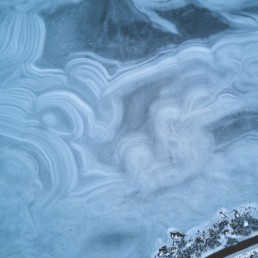
See that tine van down in the corner? That gives an idea of the dimensions. I was blown away, both by the scale and the fact that i had overlooked this image for years.
Book Recommendation: Arctic by Vincent Munier
Over the last year, together with my close friend Stian Klo, I have built quite a nice collection of photo books. It has become almost an obsession and these days I find myself searching through the dark corners of the world wide web , looking for rare editions of Japanese landscape books. I have become a book junkie, constantly chasing the next fix.
So i figured I might put out some recommendations on which books are worth getting. There are so many books out there and its easy to get lost in the jungle of mediocre books. It could be worth keeping in mind that in my opinion images that look great on screen, don’t necessarily work so well in printed format. There is also so many other factors that have a huge impact on the final result when it comes to books. Most importantly i find the choice of paper to be crucial. This is where many self publishing photographers choose to save money. Because there really is a lot of money to be saved when choosing a cheaper paper. When I decided on the paper for HEIME I went for the most expensive, heaviest matt paper I could find. Compared to choosing a semi glossy thinner paper, it doubled the cost of the book. So it makes perfect sense for many to go for a less expensive paper. But it is such a wonderful experience working your way through a book printed on thick non-reflective paper. I cant get enough of it!
So why should you invest in photo books? For inspiration! Great books can provide you with fresh inspiration and make you grab your camera and get lost in nature again. I find so much joy and inspiration, and a great deal of learning elements, through books.
The book that really got me into all of this is this first one that i will recommend. Vincent Munier is a French wildlife and landscape photographer specialized in photographing harsh and challenging environments in the Arctic. Camping out for weeks and months waiting for the moments where animals and landscape becomes one, its a highly impressive accomplishment. Most of the images are high key ,colorless and captured in almost white-out conditions. The use of contrast is sublime and its so simple, yet extremely effective. A great photograph, to me, is one that leaves you with feeling something. Munier’s work leaves me impressed, speechless, wondering and daydreaming of photographing something remotely as stunning as what I’m looking at. His images of polar bears and wolves in particular are next level stuff. But also his landscape work speaks to me deeply. As a child of the arctic, living my entire life in the north being closely connected to winter, snow and ice, his way of showing the beauty in the harsh and quite “common” arctic scenery is just highly impressive. Composition is always flawless, his processing is tastefully kept to a minimum. Just quality work from start to finish.
The book itself is pure quality. The matte heavy paper is the perfect match for these images. Its like you can feel the rocks through the snow on paper. Presentation is so elegant and tasteful and i just flipped through the whole thing in awe. It also comes with a behind the scenes booklet, describing what it was like capturing these images. It makes you realize that what most consider adventuring, is nothing but a walk in the park compared to what Munier put into his work. That’s inspirational, it makes me want to push my own limits and get out there to battle the elements.
If you ever want to buy a photo book, this is the one you should start with.

